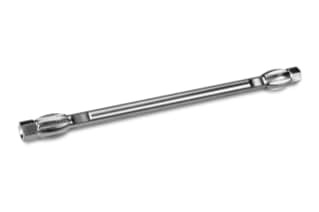
|
Chemistry |
Phenyl |
|
Separation Mode |
Reversed Phase |
|
Particle Substrate |
Hybrid |
|
pH Range Min |
1 pH |
|
pH Range Max |
12 pH |
|
Maximum Pressure |
6000 psi (415 Bar) |
|
Endcapped |
Yes |
|
Bonding Technology |
Phenyl-Hexyl |
|
Silanol Activity |
Low |
|
Particle Shape |
Spherical |
|
Particle Size |
5 µm |
|
Endfitting Type |
Waters |
|
Pore Size |
130 Å |
|
Format |
Column |
|
Surface Area |
185 |
|
System |
HPLC |
|
Particle Technology |
BEH |
|
USP Classification |
L11 |
|
Inner Diameter |
4.6 mm |
|
Length |
150 mm |
|
Carbon Load |
15 % |
|
UNSPSC |
41115709 |
|
Brand |
XBridge |
|
Product Type |
Columns |
|
Units per Package |
1 pk |

XBridge BEH Phenyl Column, 130Å, 5 µm, 4.6 mm X 150 mm, 1/pk
Leverage complementary selectivity to C18 stationary phases, especially for polyaromatic compounds, by using the XBridge BEH Phenyl Column. This lab equipment is the most chemically stable commercially available Phenyl sorbent on the market. It offers crucial analysis benefits such as ultra-low column bleed, long column lifetimes, and excellent peak shape.
The XBridge BEH Phenyl Column makes it possible for you to leverage unmatched column lifetime to meet the needs of chromatographic analysis. The analytical column offers the flexibility to work across a range of mobile phase pH and temperature, which is a unique feature in chromatographic analysis equipment. Using the XBridge BEH Phenyl Column, you can also seamlessly transfer methods to UPLC technology.
Wherever you require alternative selectivity for separations, you can easily depend on the XBridge BEH Phenyl Column with confidence. This is especially useful for analytes that contain an aromatic ring. When it is compared to any traditional phenyl liquid chromatography columns, the XBridge BEH Phenyl Column offers a wider usable pH range, allowing more robust method development. This is made possible by the use of the novel bonding and end-capping of the BEH particle technology on which the XBridge BEH Phenyl Column is based. Further, the trifunctional bonding of the phenyl hexyl-ligand enables the analytical column to offer exceptional low and high pH stability, which in turn makes it the most reproducible phenyl column in the market.
The XBridge BEH Phenyl Column provides alternate selectivity for compounds containing an aromatic moiety when compared to straight-chain-alkyl columns and embedded-polar-group columns. This results in higher flexibility in developing orthogonal methods for particularly challenging separations.
Shop for lab equipment and find all products that work in conjunction with the listing here, as well as other variants of the same listing, using our website.
Also explore the XBridge BEH Phenyl VanGuard Cartridge, 130Å, 5 µm, 3.9 mm X 5 mm, 3/pk, which is made using the same packing materials as your analytical column and specially designed to protect it from harm.
What Is Meant By PAH Analysis?
PAH stands for Polynuclear aromatic hydrocarbons (PAHs). These are carcinogenic compounds that are commonly found in the environment as a result of incomplete combustion of tobacco, tar, and fuels. Many regulatory methods exist for the analysis of these compounds in all kinds of samples, such as air, water, soil, and food.